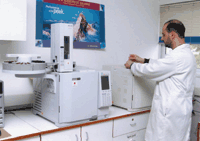
Capturing the Benefits of Biomedical Innovation in Developing Countries: Indonesia and Jordan
Indonesia is the fourth most populous country in the world, and is host to the world’s second greatest range of biodiversity. Jordan, with four million inhabitants, is relatively small, with little biodiversity, few natural resources and no oil reserves. Yet, both countries have strong potential in biomedical innovation: Indonesia in the natural medicines market; and Jordan in the pharmaceutical industry – the country’s second largest export earner. Despite fundamental differences in their size, structure, resources and geopolitical context, both countries have developed intellectual property (IP) strategies, which aim to promote public benefits from domestic biomedical innovation.
This article explores the institutional settings which ensure that IP policies relating to biomedical research help contribute to public welfare, highlighting the different approaches taken by Indonesia and Jordan. It draws on studies shortly to be published by WIPO, which analyze innovation in the life sciences in a range of developing countries.
Managing IP in the public interest
Innovation in the life sciences - including health and agricultural research – aims to serve basic human needs: food, health, a clean environment. Policy makers face the challenge of shaping incentives through the IP system to ensure those needs are addressed. Promoting biomedical innovation, and managing the resulting IP for broader public welfare, requires a systematic approach to addressing key public interest goals - such as building indigenous innovation capacities, creating affordable medicines, capturing welfare benefits from publicly-funded research, and harnessing private sector resources to serve the public interest. This approach is ideally supported at three levels by:
- a balanced regulatory framework;
- accountable and effective public institutions; and
- effective use of public and private resources, including through partnerships.
The regulatory framework
IP regimes cannot be seen in isolation from the broader regulatory context, especially in the field of life sciences. Both Indonesia and Jordan have set IP policy within the broader public policy picture. "Jordan Vision 2020", a private sector initiative under the patronage of King Abdullah II and supported by the Jordanian Government, identifies biotechnology as lying "at the heart of competitive innovation … over the next 20 years," and highlights knowledge management as a means of strengthening competitive advantage. An export-driven pharmaceutical sector is one objective of this plan. The Ministry of Planning and International Cooperation is responsible for coordinating public policy measures to promote innovation and for evaluating Jordan’s global competitiveness.
Both Indonesia and Jordan have undertaken extensive legislative programs to bring their IP laws into compliance with the WTO Agreement on Trade-Related Aspects of Intellectual Property Rights (TRIPS). Both have acceded to the Paris Convention, the WIPO Convention and the Patent Cooperation Treaty. Jordan has also signed the Protocol relating to the Madrid Agreement Concerning the Registration of Marks (ratification pending), and has entered a bilateral trade agreement with the United States with implications for its IP laws.
In Indonesia, close coordination between the Ministry of Research and the IP Office includes the screening of research grants to public institutions by the IP Office, to assess the extent to which the proposed research may generate future IP. Grant applicants are assisted in conducting a patent search, which supplements their literature review. Indonesia also offers funding to patent applicants from local companies and public research institutions.
Ownership of IP generated within Indonesia’s public research institutions is now held and exercised by the institutions themselves. This arrangement enabled the establishment of ten technology transfer offices throughout the country in the early 1990s, and virtually all major public research institutions dealing with biomedical innovation in Indonesia now have a technology transfer center (also known as IPR units/clinics/management or licensing offices). The centers have succeeded in establishing a number of business operations in recent years. The Technology Institute of Bandung has struck international licensing agreements and research collaborations with national companies, which actively seek to meet local needs. One such public-private partnership, for example, has produced a new machine for harvesting local agricultural crops.
Accountable and effective public institutions
The benefits of the regulatory framework depend in turn on establishing public institutions that are both accountable and effective in serving the public. These obligations go beyond the traditional institutional objectives of IP offices in administering the patent and trademark system.

The technology transfer center of Jordan’s Royal Scientific Society has a remit to exploit the institution’s technical capacity "for the good of society." (Courtesy of the RSS)
Jordan’s IP office reports to the Ministry of Industry and Trade; Indonesia’s to the Ministry of Justice and Human Rights. Both IP offices are accountable and transparent in their day to day decision-making processes. Regardless of the difference in size - Indonesia processes some 4,000 patent filings per year compared to Jordan’s 200 - both offices focus on the operational challenges of serving diverse stakeholders with limited resources. Both also confront the familiar problem of finding qualified technical staff to deal with the increasingly complex field of life sciences, and thus ensure patent quality.
The Indonesian IP office also pursues an active dialogue with the Food and Drug Administration of the Ministry of Health in the context of trademarks for natural medicine. In Jordan the Higher Council for Science and Technology (HCST), which is responsible for promoting dialogue on IP policy, has created an IP committee to ensure that IP is always taken into account in Jordan’s innovation policy. The HCST also engages in outreach activities on IP management within the Royal Scientific Society and the research community.
Public-private partnerships
Innovation in the field of life sciences is often characterized by ‘upstream’ or basic research conducted by public sector or academic researchers, plus a dependence on the private sector to commercialize the basic research and produce finished products. This has led to the proliferation of public-private partnerships, with diverse approaches to managing the relationship between those conducting early research, and those investing in the product development phase.
Public sector research institutions can leverage their IP holdings to ensure adequate returns from public investment in research, whether those returns are defined in financial terms, or in terms of broader benefits for society. It is also the responsibility of public sector IP managers to ensure that scientific innovation with the potential to serve public needs is not left on the shelf. Technology transfer centers situated within universities have a dual role of looking out for public interests as well as of mediating between academia and the market – and so contributing to national capacity to nurture innovation-based growth.
Indonesia has developed a strong framework for public-private partnerships. The Indonesian Institute of Sciences (LIPI) provides IP courses for its researchers, and a LIPI unit devoted to IP issues, which reports straight to the Director General, has issued several licenses. The specialized unit, has helped LIPI to form alliances with research institutions overseas, such as Germany’s Max Planck Institute, in which all IP generated is jointly-owned by both research partners.
In Jordan, there are several examples of university-private sector collaborative projects in biomedical R&D, although the emphasis so far has been on private-sector led research, and the question of a suitable legal framework for ownership of IP created from publicly funded research is still under discussion. This, plus the fact that Jordanian academics have a heavy teaching load, means that public-private partnerships are still relatively rare. Jordan’s renowned Royal Scientific Society (RSS) has an applied research orientation, and the RSS’ strategy has hitherto been based more on providing services to business partners, than on establishing public-private partnerships for developing new technology. These relationships between academia and the private sector activities hold the promise, however, of further institutionalized partnerships, and the promotion of public-private partnerships are a key strategy within the King Abdullah II Vision 2020.
| Reversing Jordan’s Brain Drain |
|---|
|
Inspired by an appeal from King Abdullah II to Jordanian entrepreneurs living overseas, Dr. Ahmad Al-Ghazawi left the U.K. in 2002 to return to Jordan and set up a biotechnology company. "I wanted to do something high-tech," says Dr. Al-Ghazawi, "and I didn’t want to do it in San Diego." Already a patent holder, including as co-inventor of a US$2 billion anti-depressant drug, he decided that Jordan was the place to start up an innovative drug company, both because of the IP legal reforms which had been put in place plus the plentiful supply of well-educated, and relatively low cost, talent from Jordan’s universities. By 2004, his Triumpharma company had begun offering bioanalytical, clinical research, and pharmaceutical R&D services. The company established relationships with local hospitals and nurses, and is now providing services such as in-vivo and in-vitro tests, toxicity studies, and animal and human trials on behalf of U.S. and European clients. Dr. Al-Ghazawi’s longer term strategy, however, is that these services will subsidize internal R&D efforts aimed at innovating new therapies. He is focusing on developing new drug delivery systems by converting off-patent molecules that have side effects and absorption problems into improved, patented molecules. Dr. Al-Ghazawi explains that improved drug delivery R&D demands lower initial investment, and that time-to-market can be 3-4 years rather than the 10-12 years that characterizes the kind of radical innovation R&D carried out by the big U.S. and European companies for which he formerly worked. Triumpharma has so far filed for four patents. For more see: Profiles in Creativity and Innovation, Creative & Innovative Economy Center, George Washington University. |
Moving forward
Jordan’s pharmaceutical industry is shifting away from generic manufacturing and towards biomedical innovation. Six out of the twelve Jordanian pharmaceutical companies now own patents, several of which are potential blockbusters. In just five years following the reform of Jordan’s patent legislation in 2000, the Jordan Pharmaceutical Manufacturing Company (JPM) alone, for example, built a portfolio of 30 patents, which JPM’s general manager, Dr. Adnan Badwan, estimates to be worth some US$200 million. This is a striking development given that, until recently, these companies made little or no use of the patent system.
Measures taken by Indonesia to bolster its overall innovation promotion strategy include promoting awareness of the economic opportunities in the natural medicine market, where annual growth rates are as high as 20 percent. Indofarma, one of Indonesia’s leading pharmaceutical firms, has made considerable investments in the development of traditional Indonesian medicines, or jamu, into new pharmaceutical products, for instance collaborating with Gadjah Mada University to discover derivatives of curcumin from the traditional medicinal plant curcuma domestica (turmeric).
Indonesia and Jordan provide complementary examples of how appropriate institutional structures, combined with more diverse and tailored approaches to managing IP in the public interest, can help a country to promote and benefit from domestic biomedical innovation.
With major health and social needs at stake in this sector, particularly in developing countries, the challenge of achieving a balance between the exercise of exclusive commercial rights and greater equity in the distribution of benefits from technological advancement is of fundamental concern for the public and policy makers of all nations.
The WIPO Magazine is intended to help broaden public understanding of intellectual property and of WIPO’s work, and is not an official document of WIPO. The designations employed and the presentation of material throughout this publication do not imply the expression of any opinion whatsoever on the part of WIPO concerning the legal status of any country, territory or area or of its authorities, or concerning the delimitation of its frontiers or boundaries. This publication is not intended to reflect the views of the Member States or the WIPO Secretariat. The mention of specific companies or products of manufacturers does not imply that they are endorsed or recommended by WIPO in preference to others of a similar nature that are not mentioned.
